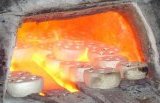
 Traditional glass beads of Ghana are often referred to as Krobo beads, the Krobo mountains being the main area of production. These beads are made from recycled glass. Bottles and other glass items are first washed and sorted by colours. They are then broken into small fragments for making translucent beads, or pounded with a metal mortar and pestle, and sieved to get a very fine powder for making powder glass beads. Glass powder of different colours is obtained using ceramic dyes.
Traditional glass beads of Ghana are often referred to as Krobo beads, the Krobo mountains being the main area of production. These beads are made from recycled glass. Bottles and other glass items are first washed and sorted by colours. They are then broken into small fragments for making translucent beads, or pounded with a metal mortar and pestle, and sieved to get a very fine powder for making powder glass beads. Glass powder of different colours is obtained using ceramic dyes.
The picture below shows various clay moulds used for beads. Moulds are coated with kaolin to prevent fused glass from sticking to the surface. As shown below, the star shaped mould and the other two filled with coloured glass powder have cassava stalks put into them. The stalks burn during the fusion leaving holes for threading the beads. The mould in the center with multiple holes is used for waist beads.
As shown below, the star shaped mould and the other two filled with coloured glass powder have cassava stalks put into them. The stalks burn during the fusion leaving holes for threading the beads. The mould in the center with multiple holes is used for waist beads.
The left picture shows the filling of a mould with glass fragments to make translucent beads.

The two pictures on the right show how Bodom beads are designed. These beads are traditionally worn by chiefs. They are usually yellow with a diamond shape design of a darker colour (in blue on the image). It is by using a small funnel and a thin stick that the craftsman creates the design with layers of different colours.
Beads are cooked in traditional kilns made of termite clay.
Translucent beads require cooking 35-45 minutes at a temperature of 850-1000 deg. Celsius
Powder glass beads require cooking 20-30 minutes at 650-800 deg. Celsius
Celsius
Painted beads are decorated with a paste made of coloured glass powder and water, which is applied using a thin wooden stalk. They are cooked a second time to fix the decor.
The craftsman uses an awl to make the centre hole in the translucent beads as soon as they are removed from the kiln. While one awl maintains the mould in place, the other one is used for turning the bead around in the mould to shape it while the fused glass slowly hardens at air temperature.




RELATED VIDEO











